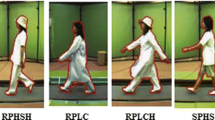Abstract
Many gait recognition methods use silhouettes as a feature due to their simplicity and effectiveness. However, silhouette-based gait recognition algorithms have the drawback of performance degradation when the silhouette images are corrupted. To solve this problem, this paper proposes a new gait representation method by emphasizing the noise-free silhouettes while suppressing the corrupted ones. The probabilistic support vector machine (PSVM) is employed to weigh the silhouette images according to quality and to construct a new gait representation for robust recognition. Experiments are conducted with the CASIA and SOTON databases, and the proposed method makes silhouette-based gait recognition as reliable biometrics.














Similar content being viewed by others
Notes
We assign the classes of clear and noisy images to “+1” and “−1” respectively. Therefore the positive direction of the normal vector in the decision boundary points to the set of noise-free silhouettes.
References
Bashir K, Xiang T, Gong S (2010) Gait recognition without subject cooperation. Pattern Recognit Lett 31(13):2052–2060
Bazin A, Nixon M (2005) Gait verification using probabilistic methods, in Proc. IEEE Workshop on Applications of Computer Vision, vol. 1, Jan, pp 60–65
Ben Abdelkader C, Culter R, Nanda H, Davis L (2001) EigenGait: motion-based recognition of people using image self-similarity, in Proc of International Conference on Audio- and Video-Based Biometric Person Authentication, pp 284–294
Bobick A, Johnson A (2001) Gait recognition using static activity-specific parameters. Proc IEEE Computer Vision and Pattern Recognition 1:423–430
Bogdanovaa A, Nikolikb D, Curfsc L (2004) Probabilistic SVM outputs for pattern recognition using analytical geometry. Neurocomputing 62:293–303
Boulgouris NV, Chi Z (2007) Gait recognition using Radon transform and linear discriminant analysis. IEEE Trans Image Process 16(3):731–740
Cover TM, Hart PE (1967) Nearest neighbor pattern classification. IEEE Trans Information Theory 13(1):21–27
Han J, Bhanu B (2006) Individual recognition using gait energy image. IEEE Trans Pattern Analysis Machine Intelligence 28:316–322
Lam T, Lee R (2006) A new representation for human gait recognition: Motion Silhouettes Image (MSI), in Proc. International Conference on Biometrics, pp 612–618
Lee H, Hong S, Kim E (2009) An efficient gait recognition with backpack removal, EURASIP Journal on Advances in Signal Processing, ID. 384384, vol. 2009
Lee H, Hong S, Nizami IF, Kim E (2009) A noise robust gait representation: motion energy image. Int J Control Autom Syst 7(4):638–643
Li X, Maybank S, Yan S, Tao D, Xu D (2008) Gait components and their application to gender recognition. IEEE Trans Systems, Man and Cybernetics 38(2):145–155
Murray M, Drought A, Kory R (1964) Walking patterns of normal men. J Bone Joint Surg Br 46-A(2):335–360
Platt J (1999) Probabilistic outputs for support vector machines and comparisons to regularized likelihood methods. Advances in Large Margin Classifiers 10:61–74
Shutler JD, Grant MG, Nixon MS, Cater JN (2002) On a large sequence-based human gait database. Proc. 4th International Conference on Recent Advances in Soft Computing, pp 66–71
Tan D, Huang K, Yu S, Tan T (2006) Efficient night gait recognition based on template matching. Proc International Conference on Pattern Recognition 3:1000–1003
Vapnik V (1988) Statistical learning theory. Wiley, NY
Wang L, Tan T, Ning H, Hu W (2003) Silhouette analysis-based gait recognition for human identification. IEEE Trans Pattern Analysis Machine Intelligence 25:1505–1518
Zhang E, Zhao Y, Xiong W (2010) Active energy image plus 2DLPP for gait recognition. Signal Process 90(7):2295–2302
Zhow X, Bhanu B (2007) Integrating face and gait for human recognition at a distance in video. IEEE Trans Systems, Man and Cybernetics 37(5):1119–1137
Author information
Authors and Affiliations
Corresponding author
Rights and permissions
About this article
Cite this article
Lee, H., Baek, J. & Kim, E. A probabilistic image-weighting scheme for robust silhouette-based gait recognition. Multimed Tools Appl 70, 1399–1419 (2014). https://doi.org/10.1007/s11042-012-1163-4
Published:
Issue Date:
DOI: https://doi.org/10.1007/s11042-012-1163-4




